Wilsontown, Morningside and Coltness Railway
Introduction
This line was completely closed in the 1970s with a short section of its E&G built extension remaining in use between Bathgate and Polkemmet Junction. After closure of the Airdrie-Bathgate line all sections fell out of use. With the re-opening of the Airdrie-Bathgate line a short portion between Bathgate Upper and Polkemmet Junction has been re-opened. The line ran from Morningside to Bathgate with branches to Carluke, Addiewell and Shotts. Plans to extend to Wilsontown, of the title, were dropped, perhaps due to the failure of the iron works there in 1842, while the line was being built. It terminated at Longridge, being extended to Bathgate by the Longridge to Bathgate (Edinburgh and Glasgow Railway) in 1850.
Why built
There were two main purposes of this line
- to deliver coal to the Coltness Ironworks- to connect to the railway network to deliver coal to other locations
Dates
Portions of line and locations
This line is divided into a number of portions.
Morningside to Longridge
The main portion of this line ran from Morningside [NB] to Longridge [1st].
The Wishaw and Coltness Railway reached Morningside around 1844 from Carluke [1st] (reached 1842) - a short distance of around 2/3 of a mile. The extension was probably driven to reach the under construction Wilsontown, Morningside and Coltness Railway rather than a desire to reach Morningside itself. It did service the Chapel Colliery in passing.
...
See also
Wishaw and Coltness Railway
This station was on the east side of Morningside Road, just south of the village of Morningside. It opened at the possible site of Morningside [1st]. A goods station existed here, approached from the east, before opening. The Ordnance Survey Name Book described it thus This name applies to a small office adjoining the Wilsontown and Morningside Railway wholly for mineral ...
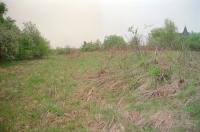
Ewan Crawford 03/05/1997
This was the junction between the North British Railway's branch to the Coltness Iron Works and the course of the Wilsontown, Morningside and Coltness Railway.
...

Ewan Crawford /12/1987
This was the junction between the Wilsontown, Morningside and Coltness Railway and the later Castlehill Branch (North British Railway). There was a loop on the original line and a single line led off to the south west for the branch.
...
See also
Castlehill Branch (North British Railway)
This siding was on the north side of the Wilsontown, Morningside and Coltness Railway and approached from the west. Blackhall Cottage was located here and Darngavel Farm was to the south. A roadbridge over the line remains here.
...
This station was at Blackhall Junction, the junction between the Wilsontown, Morningside and Coltness Railway of 1845 and the 1859 branch to the north of the Edinburgh and Glasgow Railway to the Shotts Loops, serving the Shotts Iron Works. Named for Blackhall Farm to the west. Access to the branch was from west.
...
This was the junction between the Wilsontown, Morningside and Coltness Railway of 1845 and the 1859 branch to the north of the Edinburgh and Glasgow Railway to the Shotts Loops, serving the Shotts Iron Works. Access to the branch was from west. Named for Blackhall Farm to the west.
...
See also
Shotts Branch Railway (Edinburgh and Glasgow Railway)
This signal box controlled access to Knowton Colliery. The colliery was on the north side of the line, connected to the west end of a looped siding on the main line. The signal box was on the south side.
...
This halt was north of Headlesscross Farm. The Railway Clearing House Maps shows 'Headlesscross (Gray and Paul's)'. Gray and Paul owned mines at Climpy and Wilsontown and Climpy Road ran south east to Climpy and Wilsontown, which suggests this was a loading location for coal worked to the south.
...

John Furnevel 15/09/2009
This was a single platform station with the platform on the north side of a single track line and goods yard to the north, approached from the west. There was a stone building, extended in timber to have a canopy and waiting room, on the brick built platform and a water tank at the west end.
...
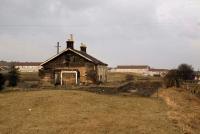
John Clark //1980

John Furnevel 15/09/2009
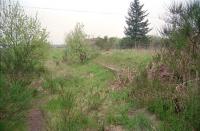
Ewan Crawford 03/05/1997
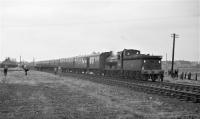
Robin McGregor 11/04/1966
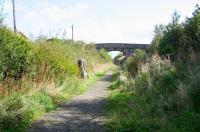
John Furnevel 09/09/2009

John Furnevel 09/09/2009

Robin Barbour Collection (Courtesy Bruce McCartney) 11/04/1966
This was the original eastern terminus of the Wilsontown, Morningside and Coltness Railway.
...
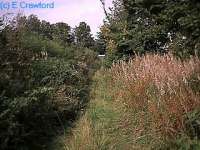
Ewan Crawford //
Coltness Iron Works Branch
This branch ran from just east of Morningside [NB] station to the iron works. This branch was one of the principal reasons why the line was built. Built by the NBR in 1890.
This was the junction between the North British Railway's branch to the Coltness Iron Works and the course of the Wilsontown, Morningside and Coltness Railway.
...

Ewan Crawford /12/1987
This junction was to the north of the Coltness Iron Works. Both the Caledonian Railway and the North British Railway had a connection to the Coltness Iron Works Railway here and this box controlled the junction between the two railway companies. The signal box was provided by the NB.
...
See also
Cleland to Morningside Line (Caledonian Railway)
Established by Henry Houldsworth (1770-1853) in 1839.
...
See also
Wishaw and Coltness Railway
Coltness Iron Works Railway
Cleland to Morningside Line (Caledonian Railway)
Kingshill Colliery Branch
This coal mine was opened just south east of Allanton by the Coltness Iron Company in 1919, producing coking and other coals. The surface buildings included a washery.
...
See also
Kingshill Collieries Railway
Crofthead Colliery Branch
Books












